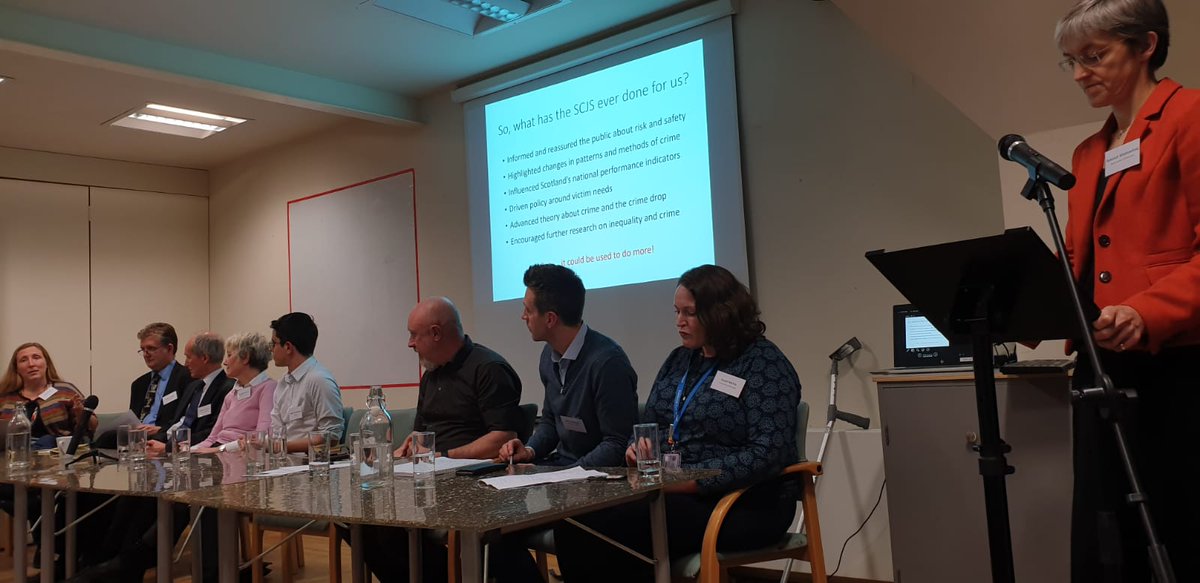The speakers asked: "What have Scotland's population surveys ever done for us?" Sarah Martin (Scottish Government), Susan McVie (University of Edinburgh), Stephen Cragg (Transport Scotland) and Mark Robinson, all spoke with reference to examples of the data in the Scottish Household Survey (SHS), Scottish Health Survey (SHeS) and Scottish Crime and Justice Survey (SCJS). They discussed how data from the surveys is used to inform policy and will continue to do so in years to come.
This was followed by discussion amongst an expert panel, with questions contributed from the audience.

So, what have the surveys done for us? Much of the discussion pointed to the surveys' roles not in painting a picture of the state of present day Scotland as an entity, but instead of deepening understanding of inequalities and divisions within the country; and suggesting that the surveys have great potential to help meet the Scottish Government's aim of reducing inequalities. The speakers identified three key ways in which the surveys can do this:
1. Deepening understanding of inequalities
We heard early on that the design of the core questions provides scope for deepening understanding of differences between subgroups, with the 20,000 combined responses from the three surveys enabling more detailed analysis by local authorities and small groups than each of the surveys alone. And it became clear that the Scottish Government surveys do indeed help to shed light on disparities in all areas of life.
Crime is one area in which the survey data has illuminated inequalities within Scotland; not only confirming that crime rates are higher in some areas of Scotland than others, but also exposing a less visible inequality: in the progress towards lower crime rates. While crime rates may have been falling steadily in Scotland for many years, this has not been shared equally, with the victims of some types of crime, such as repeat personal and violent crime, until very recently being as likely as ever to experience crime.
Further, in the area of health, the SHeS has served not only to describe health inequalities, and how they correlate with other characteristics, but to deepen understanding of how such patterns are driven. For example, analysis of data on alcohol consumption went beyond showing that consumption of alcohol is related to social status, revealing the direction of that relationship: that causality runs from social status to alcohol consumption with no evidence for reverse causation.
Transport questions also reveal the types of people who (have to) travel more, perhaps not the most immediately obvious social inequality, but one Transport Scotland aim to reduce nonetheless; with differences apparent by household composition and size, as well as working status, age, gender and income.
2. Informing new policies to address inequalities
This new knowledge has been pivotal in informing the design of policy interventions. Understanding health risk behaviours such as alcohol consumption as solely an effect, rather than a cause of social inequality, has supported the need for a policy approach that focuses on tackling underlying structural inequalities that drive health inequalities, as well as addressing alcohol consumption itself, and has in turn shaped the Scottish Government's national performance indicators. It has also helped to inform the Scottish Government's minimum alcohol pricing (MUP) policy (2012) as well as other health interventions.
 3. Monitoring and evaluating policy
initiatives
3. Monitoring and evaluating policy
initiatives
Finally,
beyond shaping the design of new policies, Scotland's population surveys
provide a valuable evidence base for monitoring progress in tackling
inequalities over time. We heard from speakers how the survey data can and
already has been used to evaluate initiatives such as those mentioned above and
inform the reformulation of policies. In addition to shaping the Minimum
Unit Pricing of Alcohol, the survey data will also be key in monitoring its
impact over time, as well as tracking the effects on the sugar tax on the
groups most likely to be effected.
In
transport, there could be scope for potentially monitoring the impact of
initiatives on people’s working choices, such as working patterns, working
styles (for example working from home), where people work and the jobs they do,
which are all shaped by travel options.
While
the surveys prove extremely useful to policymakers and decision makers already,
it was felt that there was scope for yet greater use of the findings in
future.
Many
thanks to all the speakers and panel members.
To find out more about the Scottish Household Survey (SHS), read this year's
Annual Report.
The 2018 Scottish Health Survey (SHeS) report is also available
here.
The Scottish Crime and Justice Survey (SCJS) 2017-2018 report can be found
here.
The latest results to the Scottish Surveys Core Questions are available
here.